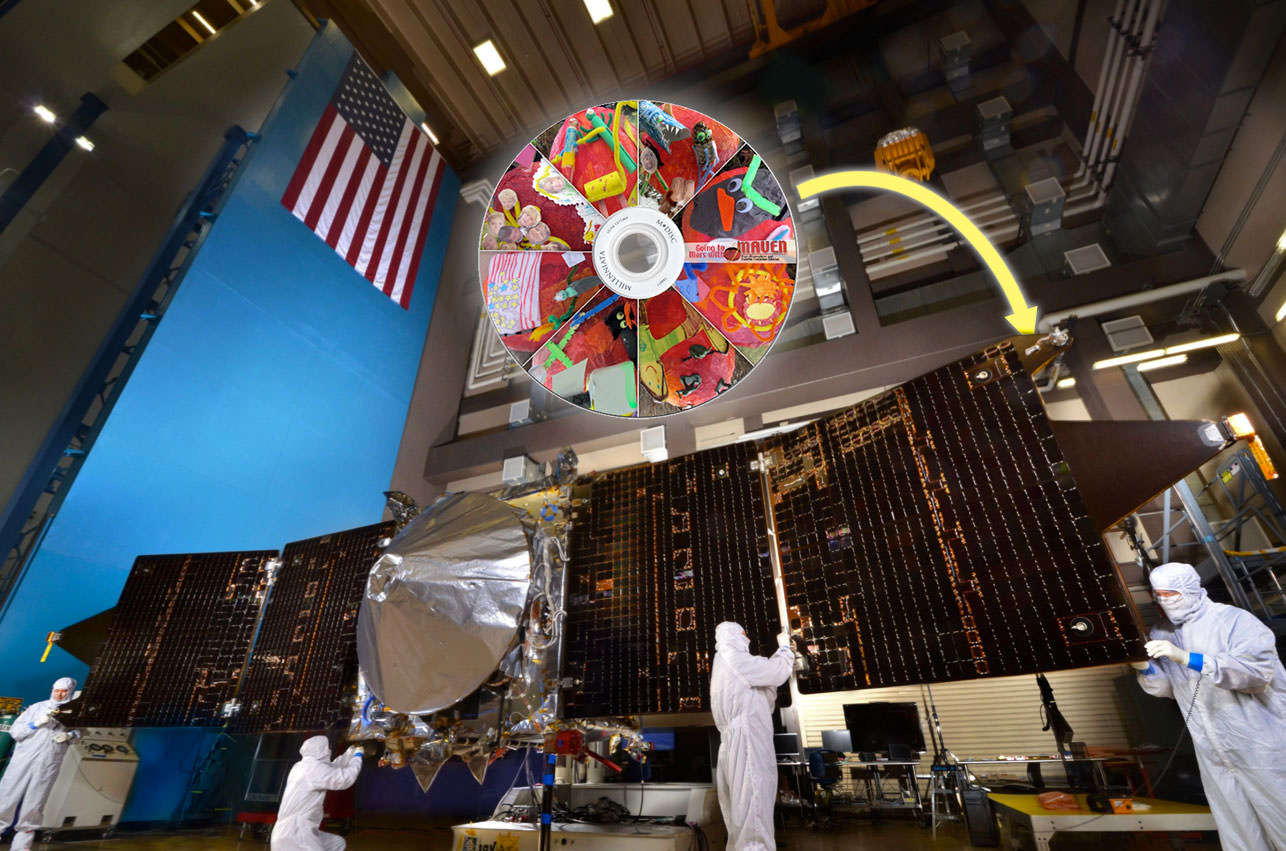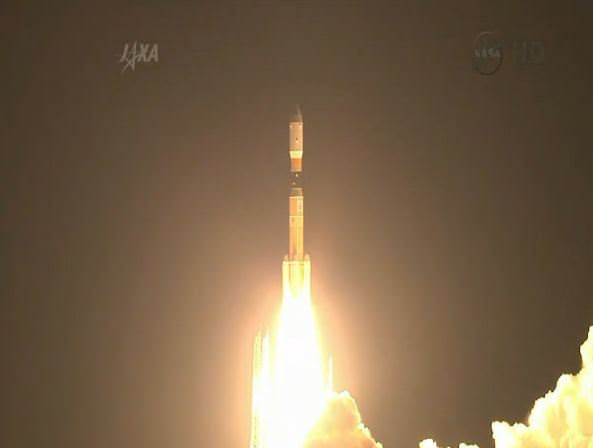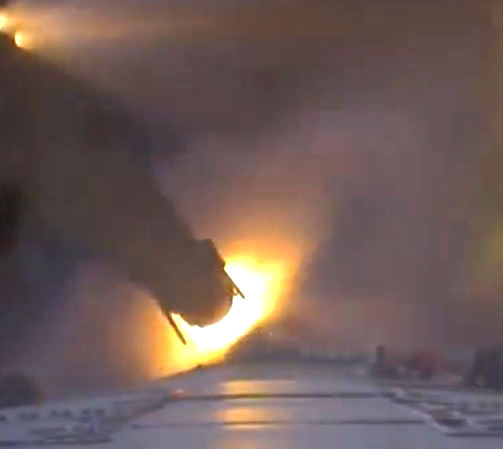These custom road signs at NASA’s Wallops Flight Facility are, well, out of this world with awesomeness. They refer to the recent launch of the LADEE spacecraft to the Moon and the upcoming launch this week of the Orbital Sciences Corporation Antares rocket, with its Cygnus cargo spacecraft heading to the International Space Station for a demonstration cargo resupply mission. Launch is currently scheduled for Wednesday, September 18 during a window of 10:50-11:05 am EDT (14:50-15:05 UTC).
Absolutely Incredible Photo: Frog Launches With LADEE
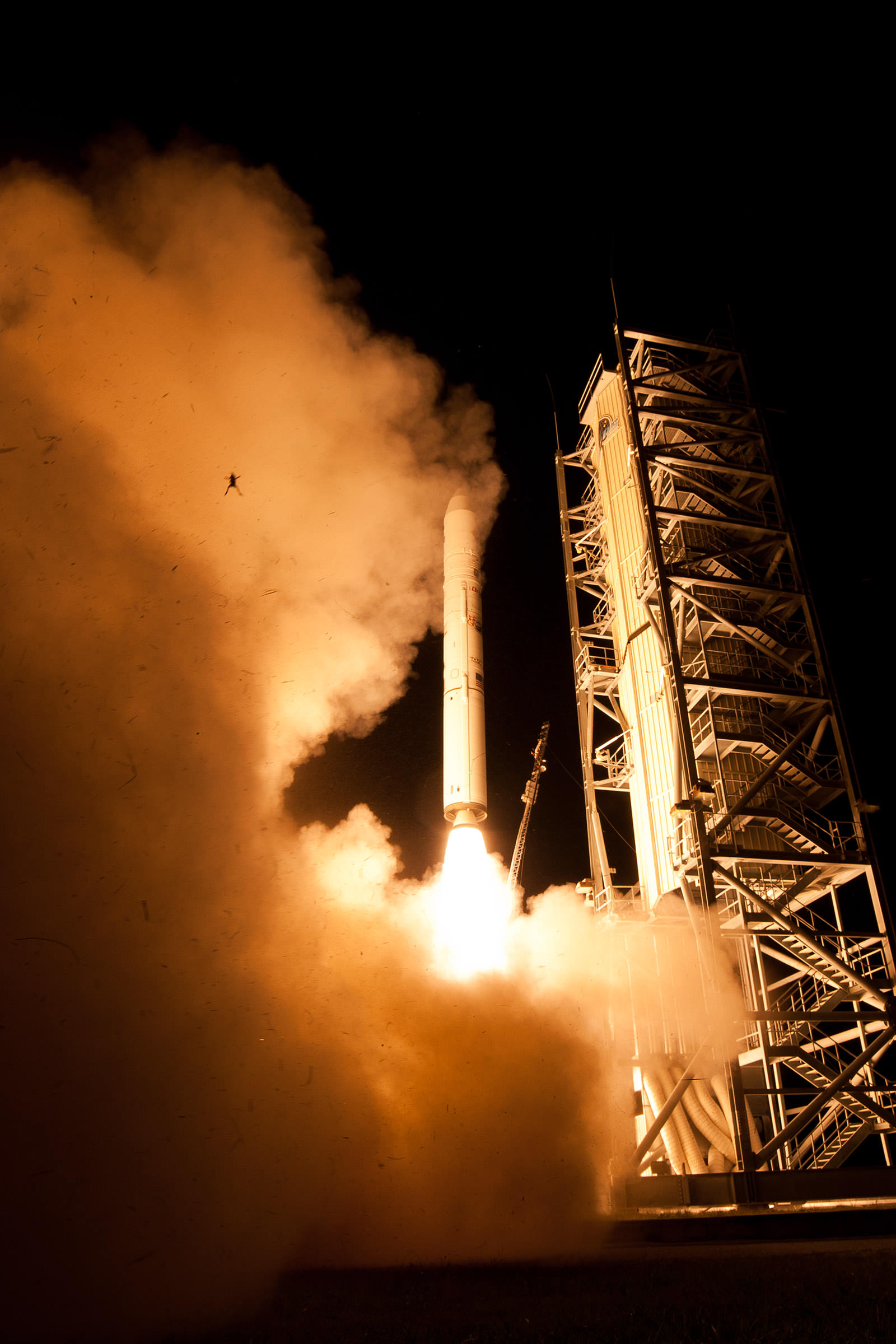
Oh my! We’re not sure to laugh or cry on this one (maybe both). This frog gives new meaning to “flying leap,” (or giant leap). This little guy was obviously startled by the ignition of the Minotaur V rocket that launched the LADEE spacecraft last Friday.
We’ve confirmed this image is in fact an actual photo taken by one of NASA’s remote cameras set up for the launch on September 6, 2013 from the Wallops/Mid-Atlantic Regional Spaceport. Wallops spokesman Jeremy Eggers confirms the picture is legitimate and was not altered in any way.
However, we cannot say with any certainty that no frog was harmed in the making of this picture.
Why would a frog be hanging around a launchpad? The launchpad at the Wallops/Mid-Atlantic Regional Spaceport has a “pool” for the high-volume water deluge system that activates during launches to protect the pad from damage and for noise suppression, and likely there was a (formerly) damp, cool place that was a nice spot for a frog to hang out.
Also, NASA has noted that like Kennedy Space Center, the Wallops Island Spaceport sits among a wildlife refuge. The 3,000 acre Wallops Island National Wildlife Refuge is comprised mainly of salt marsh and woodlands and is a habitat for a variety of species, including frogs. NASA writes:
“But how is it possible for wildlife to peacefully coexist with space operations and what effects do rocket launches have on wildlife? NASA’s launch facilities, roads, and facilities take up a small percentage of the area. The rest of the area remains undeveloped and provides excellent habitat for wildlife. During launches, short term disturbance occurs in the immediate vicinity of the launch pads, but the disturbance is short-lived allowing space launches and a wildlife habitat to coexist.”
This is not the first animal oddity to be included in a launch. There are several images of birds flying away from space shuttle launches, and in fact, during the STS-114 launch, a turkey vulture ran into the shuttle’s orange fuel tank (see video below). There was the famous space bat from the STS-119 shuttle launch in 2009, and recently the SpaceX Grasshopper test launch startled a herd of cows:
Turkey Vulture meets space shuttle:
Thanks to Karl Hille from NASA Goddard for helping to track down and verify this image.
Update (9/12/13): NASA has now posted the picture on their Solar System Exploration website (I initially found it on imgur with no credit or source info).
LADEE Launch: Images and Videos from Our Readers
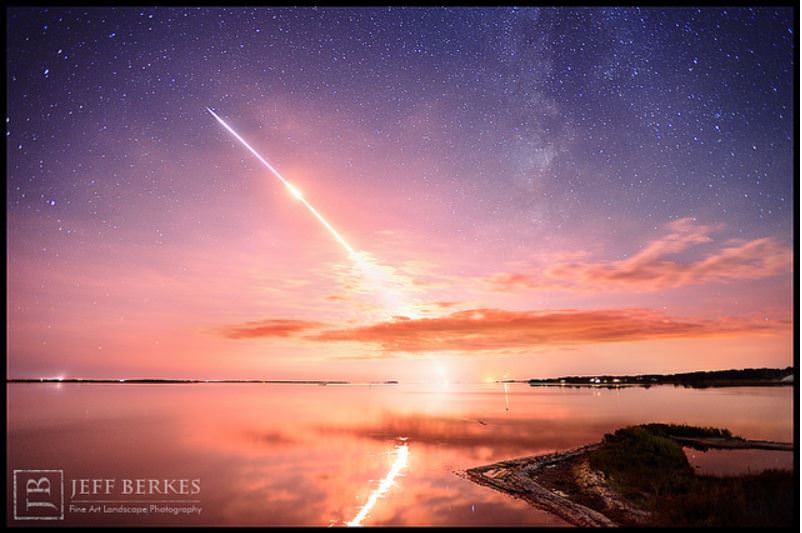
NASA’s newest mission to the Moon, LADEE, launched from Wallops Island in Virginia, lighting up the sky along the US East Coast, allowing millions to see the Minotaur V rocket’s brilliance with their own eyes. Some of our readers captured the views as they cheered on the Lunar Atmosphere and Dust Environment Explorer as it sailed safely to orbit.
See more images and video below, but first a quick update on how LADEE is doing: there was concern shortly after launch as during technical checkouts the LADEE spacecraft commanded itself to shut down the reaction wheels used to position and stabilize the spacecraft. According to the LADEE mission operations team at NASA’s Ames Research Center in Moffett Field, Calif., this was determined to be the result of fault protection limits put in place prior to launch to safeguard the reaction wheels. The limits that caused the powering off of the wheels soon after activation were disabled, and the reaction wheels were successfully brought back online.
“Our engineers will determine the appropriate means of managing the reaction wheel fault protection program. Answers will be developed over time and will not hold up checkout activities,” said Butler Hine, LADEE project manager.
Everything else is checking out fine so far, so enjoy these views:
This video was taken by Richard Drumm, part of the NASA Social LADEE launch event, so he and the group were about 2 miles from the launchpad:
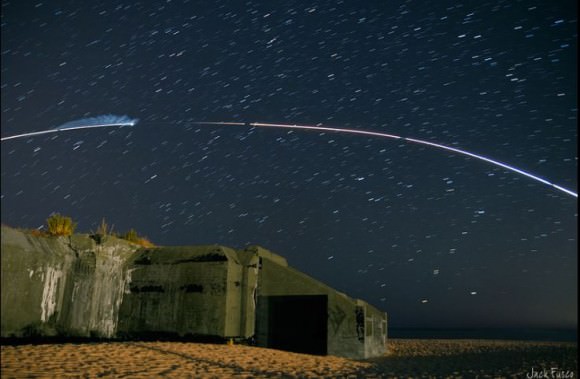
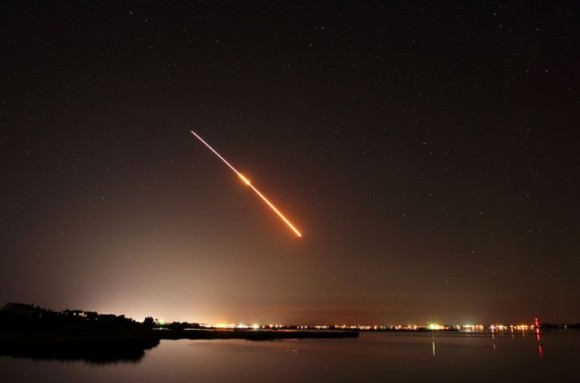
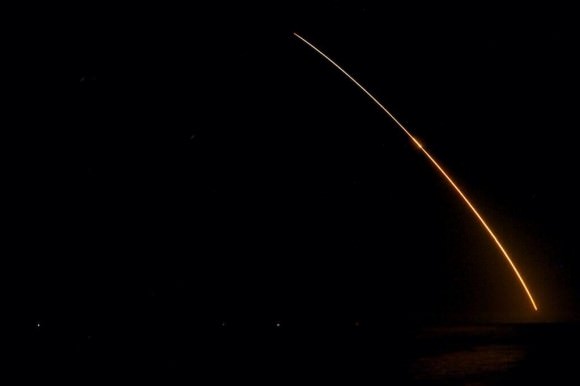
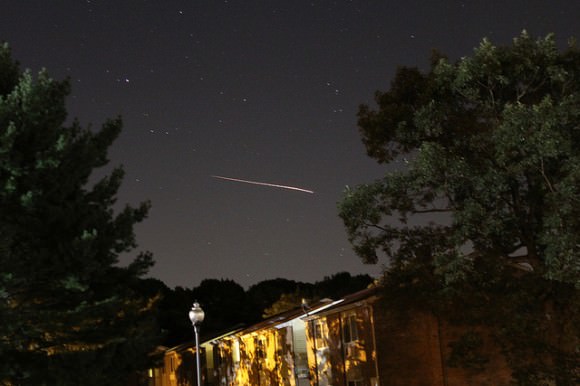
This timelapse of the launch is from Chris Moran:
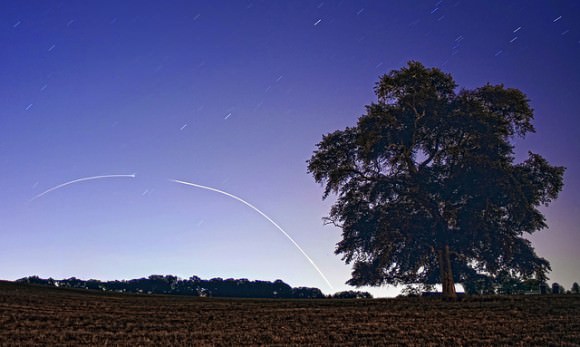
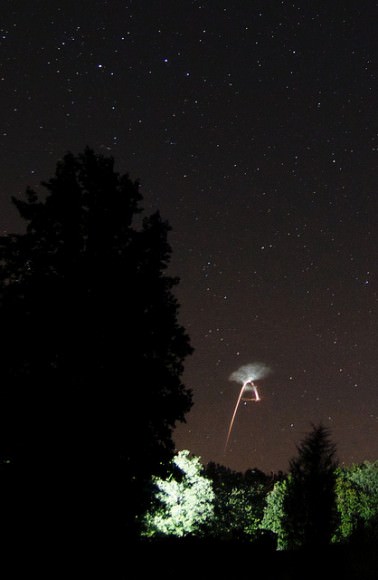
Closeup view of launch via markyj on Instagram:
LADEE launch video , as seen from Bristol, Pennsylvania, courtesy of Ron Roberts:
If you missed the launch, here’s the “official” NASA video:
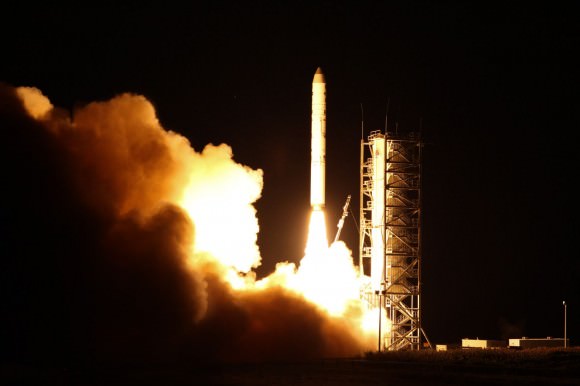
Read more about the launch in our post-launch article here.
You can see more great images in NASA’s Flickr pool for the LADEE launch here.
Want to get your astrophoto featured on Universe Today? Join our Flickr group or send us your images by email (this means you’re giving us permission to post them). Please explain what’s in the picture, when you took it, the equipment you used, etc.
Watch LADEE Launch Live!
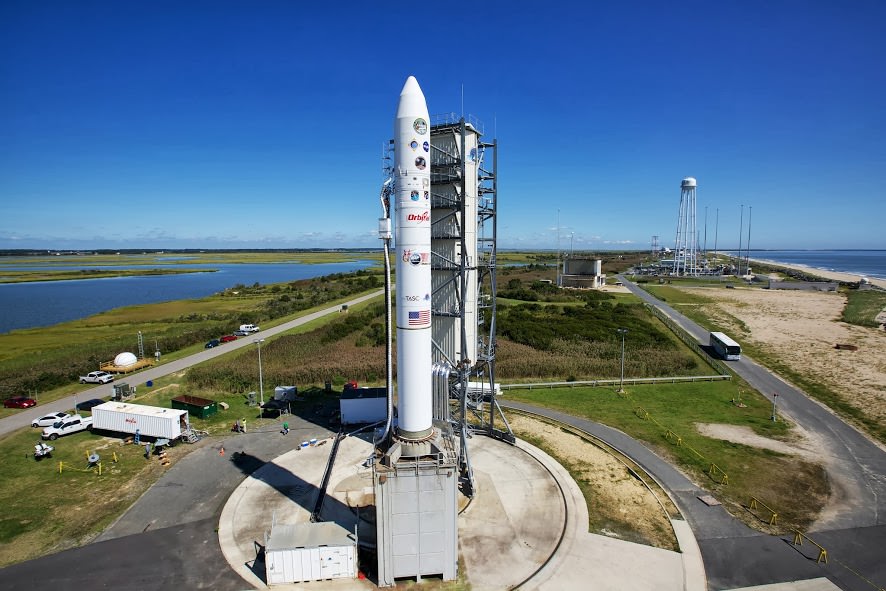
NASA’s heading back to the Moon, and you can see the launch – either live with your own eyes if you live on the US Eastern Seaboard, or online here or on NASA TV. The mission is LADEE, the Lunar Atmosphere and Dust Environment Explorer. As of this writing, the spacecraft sits atop a Minotaur V rocket on Wallops Island, Virginia. Launch is scheduled for 11:27 p.m. EDT on September 6 (0327 UTC Sept. 7). If you live in a swath long the US East Coast that stretches from Naine to North Carolina, check out our detailed information here of how you can see the nighttime launch for yourself, weather permitting.
If you want to watch online, we’ve got NASA’s UStream feed below, and all the online action starts Friday night at 9:30 p.m. EDT (0130 GMT, early Saturday.
Of course, if you have NASA TV on your cable or satellite lineup, you can watch on your television. Another option is that The Planetary Society is also have a live show starting an hour before launch at their website. Also the NASA EDGE team also will have a webcast.
Live streaming video by Ustream
For those of you in the viewing area, if you get pictures of the launch, share them with us (and we may post them on UT!) on our Flickr page.
Read more about LADEE here.
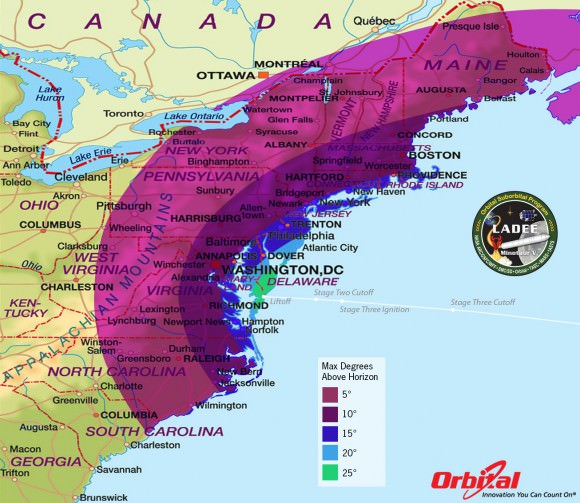
The LADEE nighttime launch will be visible to millions of spectators across a wide area of the Eastern US -weather permitting. This map shows the maximum elevation (degrees above the horizon) that the Minotaur V rocket will reach during the Sep. 6, 2013 launch depending on your location along the US east coast. Credit: Orbital Sciences
Haiku for Mars: Winners Selected for MAVEN Mission
Fans of Mars and spaceflight waxed poetic as the haiku selected to travel to Mars aboard the MAVEN spacecraft were announced earlier this month.
The contest received 12,530 valid entries from May 1st through the contest cutoff date of July 1st. Students learned about Mars, planetary exploration and the MAVEN mission as they composed haiku ranging from the personal to the insightful to the hilarious.
“The contest has resonated with people in ways that I never imagined! Both new and accomplished poets wrote poetry to reflect their views of Earth and Mars, their feelings about space exploration, their loss of loved ones who have passed on, and their sense of humor,” said Stephanie Renfrow, MAVEN Education & Public Outreach & Going to Mars campaign lead.
A total of 39,100 votes were cast in the contest; all entries receiving more than 2 votes (1,100 in all) will be carried on a DVD affixed to the MAVEN spacecraft bound for Martian orbit.
Five poems received more than a thousand votes. Among these were such notables as that of one 8th grader from Denver Colorado, who wrote;
Phobos & Deimos
Moons orbiting around Mars
Snared by Gravity
Another notable entry which was among the poems sited for special recognition by the MAVEN team was that of Allison Swets of Michigan;
My body can’t walk
My mouth can’t make words but I
Soar to Mars today
377 artwork entries were also selected to fly aboard MAVEN as well.
Didn’t get picked? There’s still time to send your name aboard MAVEN along with thousands that have already been submitted. You’ve got until September 10!
Part of NASA’s discontinued Scout-class of missions, the Mars Atmosphere and Volatile EvolutioN mission, or MAVEN, is due to launch out of Cape Canaveral on November 18th, 2013. Selected in 2008, MAVEN has a target cost of less than $500 million dollars US, not including launch carrier services atop an Atlas V rocket in a 401 flight configuration.
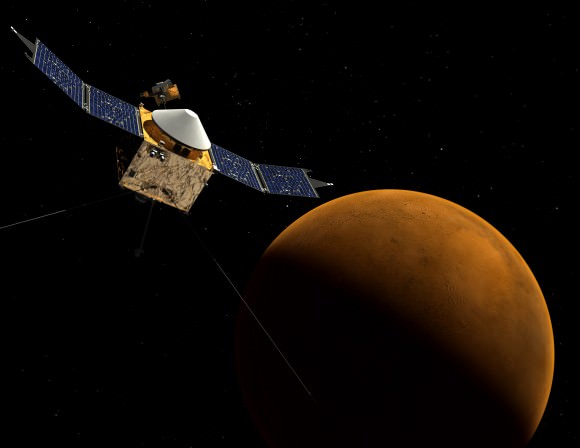
The Phoenix Lander was another notable Scout-class mission that was extremely successful, concluding in 2008.
Principal investigator for MAVEN is the University of Boulder at Colorado’s Bruce Jakosky of the Laboratory for Atmospheric and Space Physics (LASP).
The use of poetry to gain public interest in the mission is appropriate, as MAVEN seeks to solve the riddle that is the Martian atmosphere. How did Mars lose its atmosphere over time? What role does the solar wind play in stripping it away? And what is the possible source of that anomalous methane detected by Mars Global Surveyor from 1999 to 2004?
MAVEN is based on the design of the Mars Odyssey and Mars Reconnaissance Orbiter spacecraft. It will carrying an armada of instruments, including a Neutral Gas & Ion Mass Spectrometer, a Particle and Field Package with several analyzers, and a Remote Sensing Package built by LASP.
MAVEN just arrived at the Kennedy Space Center earlier this month for launch processing and mating to its launch vehicle. Launch will be out of Cape Canaveral Air Force Station on November 18th with a 2 hour window starting at 1:47 PM EST/ 18:47 UT.
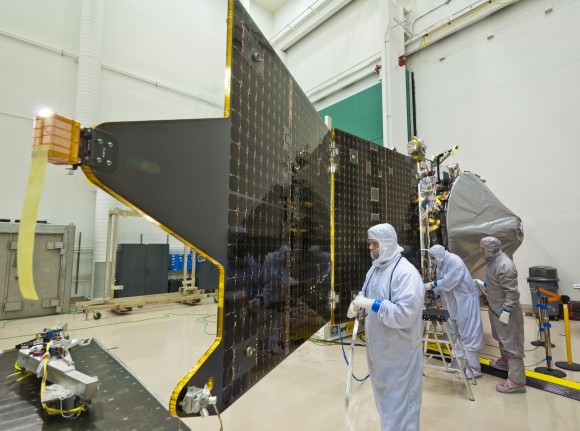
Assuming that MAVEN launches at the beginning of its 20 day window, it will reach Mars for an orbital insertion on September 22, 2014. MAVEN will orbit the Red Planet in an elliptical 150 kilometre by 6,200 kilometre orbit, joining the Mars Reconnaissance Orbiter, the European Space Agencies’ Mars Express and the aging Mars Odyssey orbiter, which has been surveying Mars since 2001.
The window for an optimal launch to Mars using a minimal amount of fuel opens every 24 to 26 months. During the last window of opportunity in 2011, the successful Mars Curiosity rover and the ill-fated Russian mission Phobos-Grunt sought to make the trip.
This time around, MAVEN will be joined by India’s Mars Orbiter Mission, launching from the Satish Dhawan Space Center on October 21st. If successful, the Indian Space Research Organization (ISRO) will join Russia, ESA & NASA in nations that have successfully launched missions to Mars.
This window comes approximately six months before Martian opposition, which next occurs on April 8th, 2014. In 2016, ESA’s ExoMars Mars Orbiter and NASA’s InSight Lander will head to Mars. And 2018 may see the joint ESA/NASA ExoMars rover and… if we’re lucky, Dennis Tito’s proposed crewed Mars 2018 flyby.
Interestingly, MAVEN also arrives in Martian orbit just a month before the close 123,000 kilometre passage of comet C/2013 A1 Siding Spring, although as of this time, there’s no word if it will carry out any observations of the comet.
These launches will also represent the first planetary missions to depart Earth since 2011. You can follow the mission as @MAVEN2Mars on Twitter. We’ll also be attending the MAVEN Conference and Workshop this weekend in Boulder and tweeting our adventures (wi-fi willing) as @Astroguyz. We also plan on attending the November launch in person as well!
And in the end, it was perhaps for the good of all mankind that our own rule-breaking (but pithy) Mars haiku didn’t get selected:
Rider of the Martian Atmosphere
Taunting Bradbury’s golden-bee armed Martians
While dodging the Great Galactic Ghoul
Hey, never let it be said that science writers make great poets!
Launch Gallery: Delta 4 Sends Military Satellite to Orbit
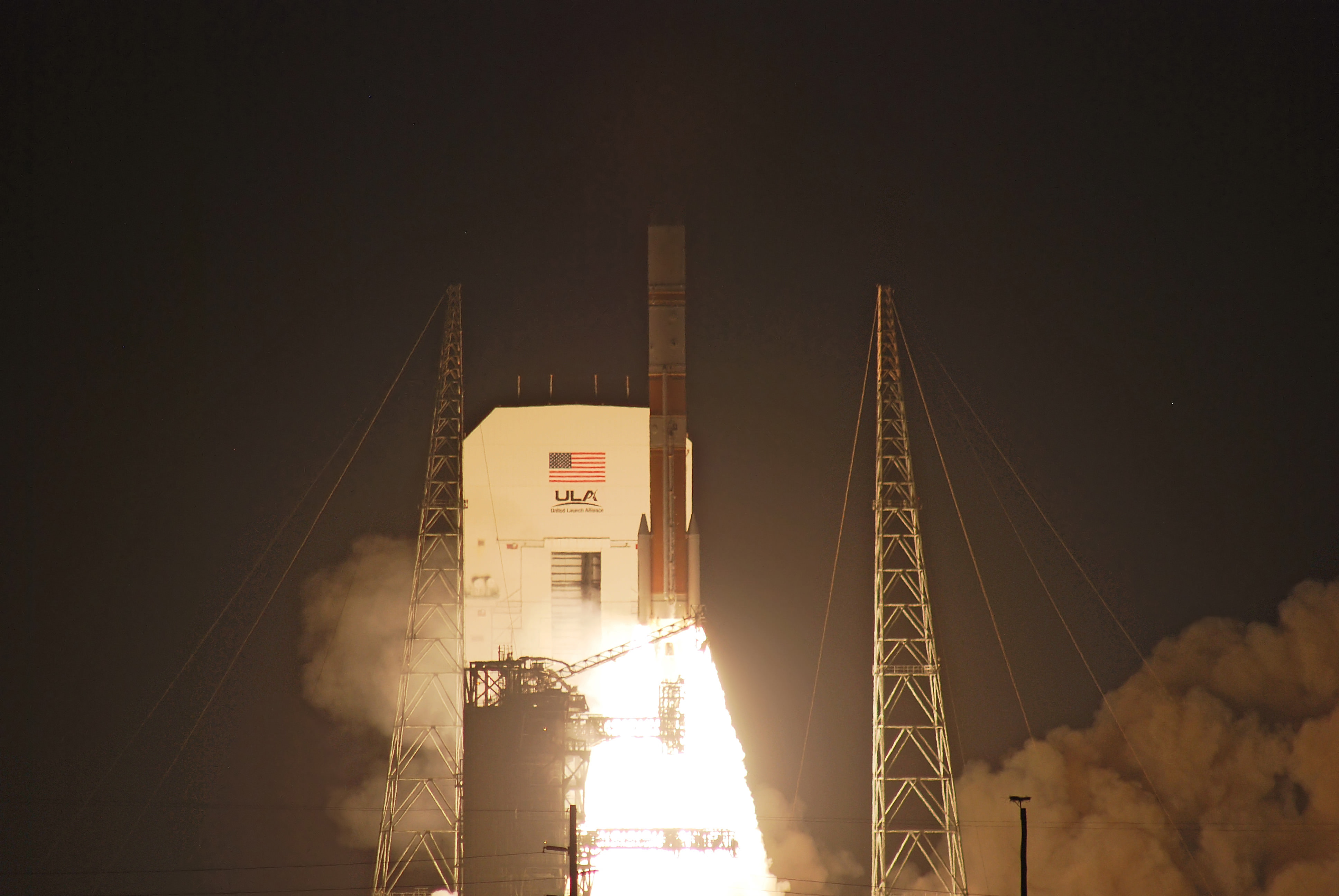
Who doesn’t like a good launch? These images and videos from last night’s launch of United Launch Alliance’s Delta 4 rocket are just pretty. The rocket boosted an international military communications satellite to orbit following a beautiful night-time launch from Cape Canaveral Air Force Station at 8:29 pm EDT on August 7 (00:29 UTC on August 8, 2013). The 21-story-tall Delta 4 included four solid-fuel strap-on boosters for extra oomph. As @OxyAstro said on Twitter last night, “I like to think of the Delta IV as an apartment building sitting on a few million lbs of thrust.”
Images here are from John O’Connor at Nasatech.net, and enjoy a close-up video of the launch, below, from Matthew Travis.
A standard video view of the launch is below.
On board was the WGS-6 (Wideband Global Satcom)a big 6,000 kg (13,200 lb) satellite that is part of a military communications network shared by the United States, Australia, Canada, Denmark, Luxembourg, the Netherlands and New Zealand.
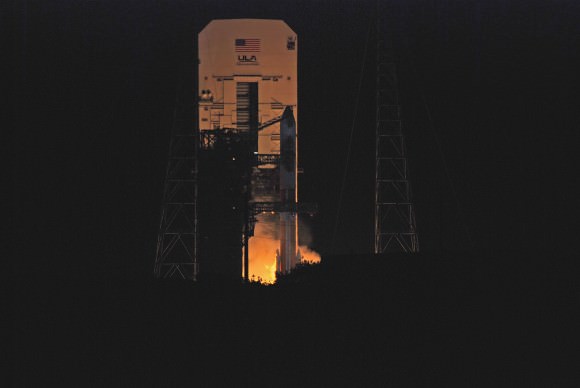
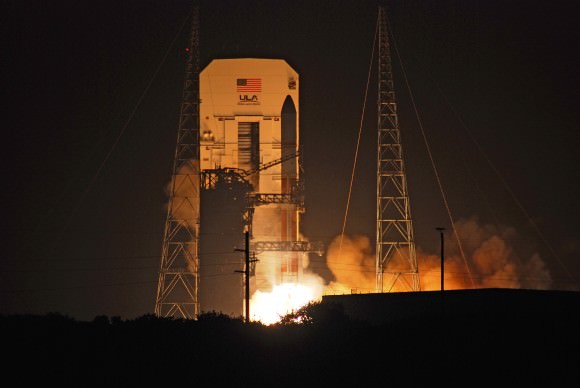
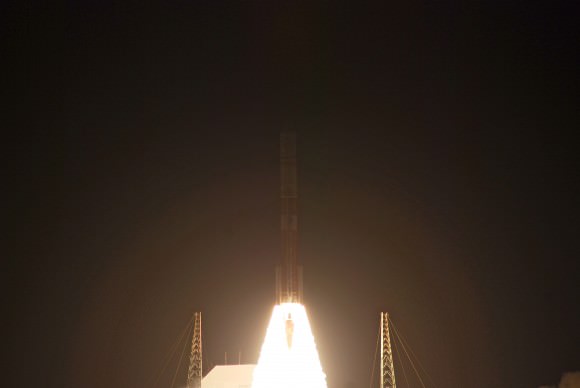
Japanese Transfer Vehicle Launches Supplies, Robot to the Space Station
More supplies and a brand new talking robot for International Space Station. The Japan Aerospace Exploration Agency’s (JAXA) HTV-4 Transfer Vehicle launched successfully from the Tanegashima Space Center in Japan, and will rendezvous in six days with the ISS. On board are 3.6 tons of dry cargo, water, experiments and spare parts to the International Space Station. The new robot, a .34 meter (13.4-inch) robot named Kirobo, is designed to be able to have a conversation with its astronaut crewmates and to study how robot-human interactions can help the astronauts in the space environment.
Unlike a Russian Progress vehicle which docks automatically, the HTV-4 will be captured by the Canadarm2 and berthed to the Harmony module. The cargo spacecraft will be commanded to fly within about 40 feet and then hold where Flight Engineer Karen Nyberg will operate the Canadarm2 during the approach and rendezvous of the Kountouri supply vehicle.
Gallery: Atlas 5 Launches US Navy’s Heavyweight MUOS-2 Satellite into Orbit
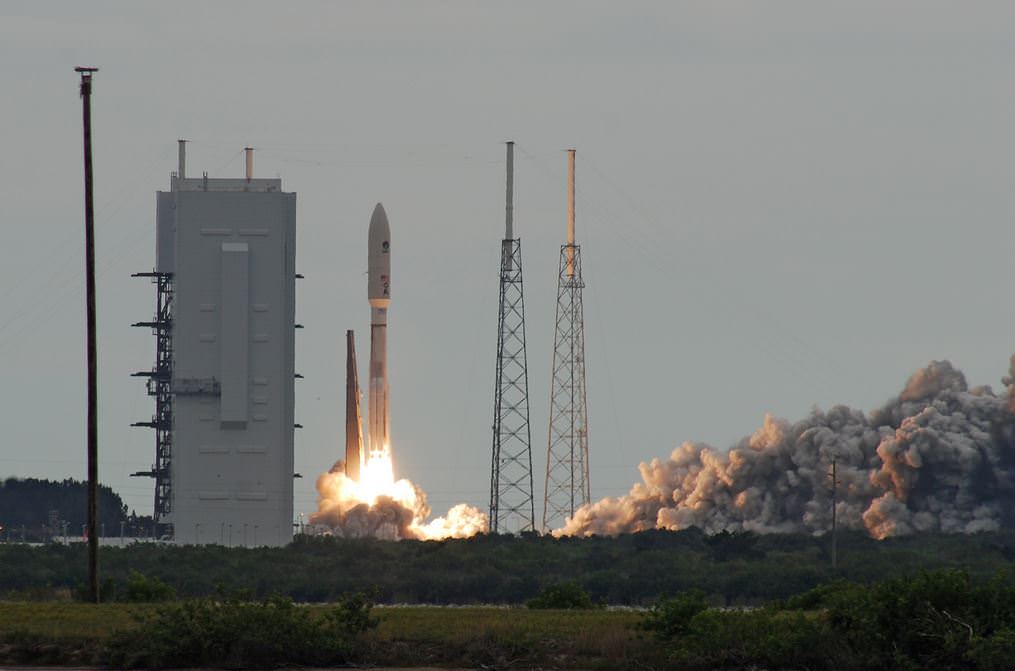
A heavyweight next generation of military communications satellites was launched on July 19, 2013 from Cape Canaveral Air Force Station, in Florida. The Mobile User Objective System (MUOS)-2 satellite launched on board a United Launch Alliance Atlas 5 rocket, and is now in the process of reaching to its final geostationary orbit.
Images here are courtesy of John O’Connor from the Nasatech website.
The satellite weighed nearly 7,000 kg (15,000 pounds) making it one of the heaviest payloads ever launched with an Atlas 5.
See more launch images below:
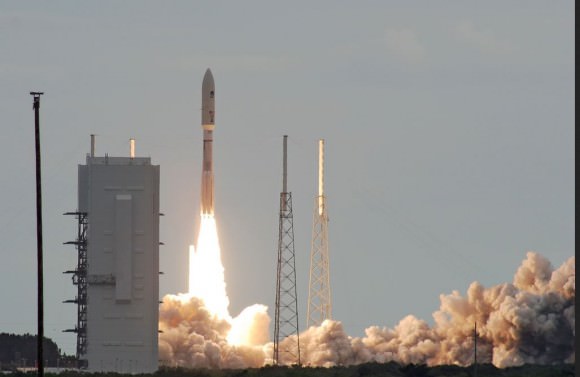
It will take about eight days to maneuver MUOS-2 into geostationary orbit according to Captain Paul Ghyzel, the Navy’s MUOS program manager.
The US Navy says the new satellite is the second satellite in a new system that supports a worldwide, multi-Service population of users in the ultra-high frequency band. The system provides increased communications capabilities, and is designed to support users that require greater mobility, higher data rates and improved operational availability.
The MUOS-1 launched in February 2012 and there will be five such satellites in the system that are described as being like orbital cell phone towers to span the globe.
The network will cost a total of $5 billion.
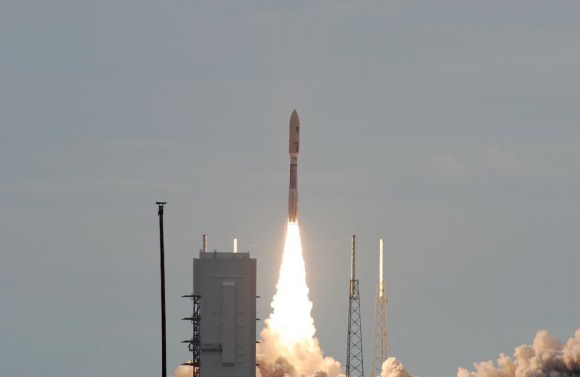
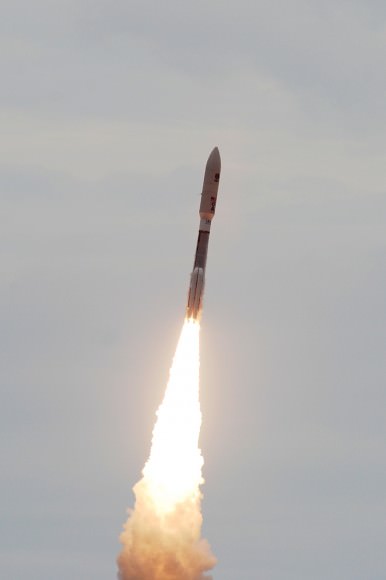
First-Ever Video of an ATV Vehicle Into Orbit!
Yesterday, June 5, the European Space Agency launched their ATV-4 Albert Einstein cargo vessel from their spaceport in French Guiana. Liftoff occurred at 5:52 p.m. EDT (2152 GMT), and in addition to over 7 tons of supplies for the ISS a special payload was also included: the DLR-developed STEREX experiment, which has four cameras attached to the Ariane 5ES rocket providing a continuous 3D view of the mission, from liftoff to separation to orbit and, eventually, docking to the Station on June 15.
The dramatic video above is the first-ever of an ATV vehicle going into free-flight orbit — check it out!
“The highlight of the STEREX deployment will be observing the settling of ATV-4 in orbit. STEREX for this event will include three-dimensional video sequences to study the dynamic behavior of the spacecraft during the separation phase. This opens up for the ATV project engineers an entirely new way to monitor the success of their work and also to gain important new experiences for the future.” – DLR blog (translated)
If you look along the horizon at around 5:20, you can make out the plume from the launch.
At 20,190 kg (44, 511 lbs) ATV Albert Einstein is the heaviest spacecraft ever launched by Ariane. Read more here.
(HT to Daniel Scuka at ESA.)
ESA Launches ‘Albert Einstein’ Cargo Spacecraft to the Space Station
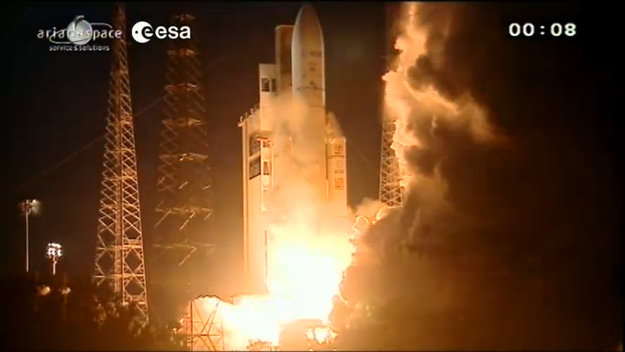
ESA used a little E=mc^2 and launched the Automated Transfer Vehicle-4 (ATV-4) resupply ship, named “Albert Einstein” in honor of the iconic physicist, famous for his handy little equation. Liftoff of the Ariane 5 rocket from Europe’s spaceport in Kourou, French Guiana occurred at 5:52 p.m. EDT (2152 GMT) on June 5, 2013. This is second-to-last of ESA’s five planned ISS resupply spacecraft; the first one launched 2008, and all have been named after scientists.
ATV-4 will take a leisurely 10 days to reach the station, with docking scheduled for June 15.
You can watch the launch video below.
The three previous ATVs were named for Jules Verne, Johannes Kepler and Edoardo Amaldi.
The 13-ton ATV-4 will deliver more than 7 tons of supplies to the station when it docks to the aft port of the Russian Zvezda service module a week from Saturday.
The cargo includes 5,465 pounds of dry cargo, experiment hardware and supplies, 1,896 pounds of propellant for transfer to the Zvezda service module, 5,688 pounds of propellant for reboost and debris avoidance maneuver capability, 1,257 pounds of water and 220 pounds of oxygen and air.
Before the ATV-4 arrives at the station, the Russian ISS Progress 51 cargo spacecraft will undock from the Zvezda port at 13:53 UTC (9:53 a.m. EDT), Tuesday, June 11.


